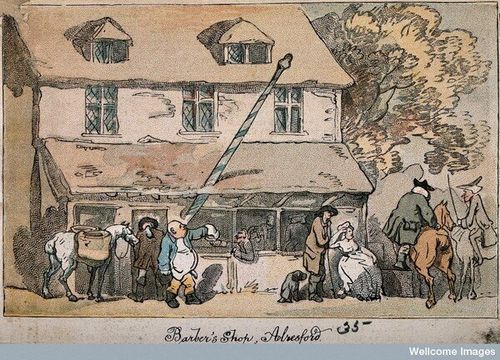

Mark Twain once wrote: 'What one experiences in a barber's shop the first time he enters one is what he always experiences in barbers' shops afterwards till the end of his days'.
He couldn't be further from the truth.
In fact, there was a time when barbers were more akin to surgeons than hairdressers, and provided much more than a simple shave and a haircut. Until the late 18th century, barber-surgeons (as they were often called) performed a variety of services: they lanced abscesses, set bone fractures, picked lice from hair and even pulled rotten teeth.
None of which I'd recommend you ask your barber to do today!
One of the keystones of the barber-surgeon's duties was bloodletting. There are many reasons why people were drained of their blood in the past. One of the main theories stemmed from a belief that blood was the product of food. When a person ate, the food was digested in the stomach and then processed in the liver, where it was turned into blood. Occasionally, a person produced an excess of blood, which led to all kinds of ailments such as fevers, headaches, even apoplexy.
As essential as bloodletting was to medical practice in earlier periods, many physicians believed the 'cutter's art' was beneath their station. Instead, they referred those who needed bleeding to the barbers, who carried out this duty with relish.
Barber-surgeons, like other craftsmen, were aware of the need to advertise their services to the greater population and went about doing so in various ways. In medieval London, barbers placed bowls of their clients' blood in their windows, ensuring that even the most oblivious passerby stopped and took notice. It was a not-so-subtle reminder that you may be overdue for your own bloodletting, like those glossy cards that your dentist sends you in the mail every 6 months with the picture of a grinning toothbrush.
In 1307, the people of London decided they had had enough of the barber-surgeons' bowls of congealed, putrid blood. A law was passed that stated: 'no barbers shall be so bold or so hardy as to put blood in their windows'. How should they dispose of unwanted bodily fluids, the barbers asked? They should have it 'carried unto the Thames' and thrown into the river.
There, much better.
Despite the ban, barber-surgeons still needed to advertise their services, and so devised another way to do so. The barber's pole quickly became recognised as the symbol of the barber-surgeon's proficiency as a bloodletter and, of course, is still used as a promotional tool today, albeit to advertise slightly different services.
The barber's pole originated from the rod that the patient gripped to make their veins bulge, thus making them easier to slice open. A brass ball at the top symbolised the basin that collected the blood. The pole's red and white stripes represent the bloodied bandages, which would be washed and hung to dry on the rod outside the shop. The bandages would twist in the wind, forming the familiar spiral pattern we see on the barber poles of today.
In 1540, a statute was passed that required barbers and surgeons to distinguish their services by the colours of their pole. From that point forward, barbers used blue and white poles, while surgeons used red and white poles. Today, red, white and blue barber poles are often found in the United States, although this may have more to do with the colours of the nation's flag than anything else. Some interpretations posit that the red represents arterial blood, the blue represents venous blood and the white represents the bandages. Spinning barber poles are meant to move in a direction that makes the red (arterial blood) appear as if it were flowing downwards, as it does in the body.
While bloodletting seems barbaric to modern eyes, patients saw it as a part of normal medical treatment, and many actively demanded it. Indeed, many people visited a doctor requesting to be bled, as in the case of the apprentice and servant, Joseph Lister (1627 - 1709), who sought a new physician after the first one disappointingly prescribed cordials in lieu of recommending him to a barber to have his blood let.
George Washington, too, was conditioned by the times. On the morning of 14 December 1799, he awoke complaining that he couldn't breathe. Fearing his doctor would not arrive in time, the first President of the United States asked for the overseer of his slaves to step in and bleed him. The cut was deep, and Washington lost nearly a half a pint before the wound was closed. Eventually, the physicians arrived, and proceeded to bleed Washington another 4 times over the next 8 hours. By that evening the President was dead. One of his physicians, James Craik, later admitted that he thought the blood loss had hastened the President's death.
Yet, despite these dangers, people continued to be bled throughout the 19th and early 20th centuries. By this time, however, the barber had traded in his lancet for a pair of scissors, giving way to what we now recognise as the barbershop.